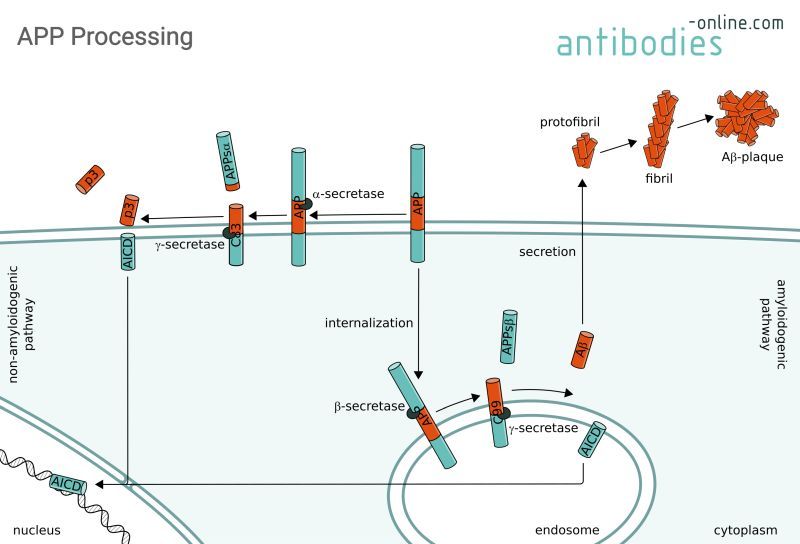Alzheimer’s disease
Alzheimer's disease (AD) is the most common form of dementia. About 50 million people worldwide suffer from AD. A further increase in the number of cases is expected by 2050, partly due to the fundamental rise in life expectancy. The clinical picture is characterised by a progressive loss of cognitive abilities. The neurological hallmarks are the presence of neuritic plaques and neurofibrillary tangles of proteins in brain tissue. Ultimately, the disease leads to death.
The majority of sporadic AD (SAD) cases remain genetically unexplained and are thought to be primarily influenced by contributing nongenetic factors such as oxidative stress, mitochondrial dysfunction, neuroinflammation, or microbial factors (e.g. HSV-1).
However, in some forms of early-onset and late-onset AD, underlying pathogenic mutations in several genes and their respective proteins have been identified as genetic risk factors to develop familial AD (FAD). For example, the presence of the ε4 allele of the apolipoprotein E (APOE4) gene increases a person’s risk for late-onset AD from the mid-60s on. Early-onset AD occurring as early as the mid-30s is less frequent and gene alterations observed in this context are in the amyloid precursor protein (APP) gene and the Presenilin 1 (PSEN1) and 2 (PSEN2) genes. Aβ and hyperphosphorylated Tau (pTau) oligomers are considered determinants of AD pathophysiology, although the exact mechanism is not yet understood.

One of the key factors for AD and central to the amyloid hypothesis as underlying cause for the disease is APP. It is predominantly proteolytically processed by α-secretase and γ-secretase in the plasma membrane (non-amyloidogenic pathway, left). End products are soluble extracellular N-terminal fragment (APPsα) and p3 peptide and the N-terminal APP intracellular domain (AICD). Processing takes place in the endosome membrane via the amyloidogenic pathway (right) by Aβ- and Aγ-secretase into N-terminal APPsβ, Aβ peptides, and AICD. AICD acts as transcription factor upon transport into the nucleus. The Aβ peptides with 38 to 43 amino acids are secreted into the intracellular space where they form fibrils and ultimately the Aβ-plaques characteristic for AD.
- Apolipoprotein E
- Amyloid Precursor Protein
- Tau
- α-synuclein
Key factors in AD:
Important targets related to Alzheimer's Disease
Based on recent literature, some of the high-interest targets for AD research are:
Apolipoprotein E
The APOE4 variant of the apolipoprotein E gene on chromosome 19 is the principal genetic risk factor for late-onset AD. It is one of three different versions of the APOE gene: APOE2 is the rarest of the three variants and is associated with a decreased AD risk. APOE3 is the most common variant and is not thought to influence developing AD. APOE4 on the other hand is a major risk factor for late onset familial AD. It causes changes in the blood brain barrier that lead to problems in synapses.
The prevalence of the APOE4 variant in the general population is around 9% to 23%. In comparison, at least one copy of APOE4 is present in 24% to 45% of AD patients and 2% to 3% have two copies of the allele (homozygosity) depending on ethnicity. Homozygosity for this allele causes earlier disease onset than in heterozygous carriers and predicts AD by age 80.
APOE Antibodies
Amyloid Precursor Protein
Proteolysis of transmembrane surface receptor APP gives rise to various amyloid-beta (Aβ) peptides. Mutations in the APP gene on chromosome 21 can impair β-secretase (BACE1) and γ-secretase (PSEN1, PSEN2, NCSTN, APH1A, APH1B, PSENEN) protease cleavage sites and increase the total amount of Aβ in the cell or the ratio of the Aβ42/Aβ40. Similarly, mutations in the APP promotor or duplication of the gene cause an elevated Aβ concentration. Protective mutation in the AAP gene on the other hand can reduce the AD risk. Several proteins are also known to modulate APP expression, e.g. APOE, ABCA7, BIN1, clusterin, PICALM, and SORLA.
Both the increase of total Aβ and Aβ42/Aβ40 ratio lead to the formation of the extracellular neuritic amyloid plaques that are characteristic for AD because of the proteins’ tendency – in particular Aβ42 – to oligomerize and from insoluble fibrils. The amyloid hypothesis posits that this clumping of Aβ peptides are the primary driver of AD. Anti-AD drugs such as lecanemab, donanemab, aducanumab, and gantenerumab monoclonal antibodies aim to clear amyloid from the brain. Some of these have shown lackluster effects in alleviating the effects of AD in later stages but slowed cognitive and functional decline in people with early symptomatic AD in a clinical trials. Alternative pharmacological approaches target β-secretase and γ-secretase to prevent APP proteolysis.
APP and Aβ peptides also influence synapse stability through interaction with the Wnt signalling pathway. On one hand APP activates canonical Wnt-b-catenin, important for synapse stability, through induction of the Wnt inhibitor Dkk1 by Aβ. On the other hand, Aβ can also activate non-canonical Wnt-signalling which leads to synapse retraction. Activation of this non-canoncial Wnt signaling pathway also increases Aβ production, resulting in a positive feedback loop that ultimately leads to synapse loss.
Neuroinflammation cause by APP proteolysis products is an additional aspect to AD. Aβ also bind to pattern-recognition receptors (PRRs) on microglia, the primary immune cells in the central nervous system (CNS). Upon recognizing Aβ as damage-associated molecular patterns (DAMP) resting microglia are activated. This triggers release of cytokines to enhance phagocytosis and Aβ uptake and clearance, inhibit inflammatory processes, and promote tissue repair. However, long-term activation of microglia gives rise to neuroinflammation causing synaptic dysfunction and neurotoxicity that exacerbates neurodegeneration.
Aβ Antibodies
β- and γ-Secretase
The mechanisms of Aβ-generation and -prevention are subject of intensive research. APP, as well as β- and γ-secretases are the principal players involved in Aβ production, while α-secretase cleavage on APP prevents Aβ deposition. Inhibitors or modulators that target β- and γ-secretases as well as α-secretase activators are promising candidates for treatment of AD.
β-secretase and γ-secretase Antibodies
Tau
Tau is a microtubule-associated phosphoprotein abundant in axons involved in promoting polymerization and stabilization of microtubules. Many neurodegenerative diseases show Tau alterations and a pathology that is characterized by intraneural neurobribrillary tangles composed of pTau oligomers. AD is considered a secondary tauopathy because the primary driver of the disease is clumping of Aβ proteolysis products.
Many kinases, including GSK3β, CDK5, MAPK, JNK, and p38, finely regulate protein Tau hypermethylation. This leads to a conformational change which impairs its association with microtubules. Consequently, Tau becomes soluble and can undergo dimerization and self-association into higher order oligomers, filaments (aka paired helical filaments, PHF) and ultimately NFTs (neurofibrillary tangles). Chaperones such as Hsp70 and DNAJA1 can reduce aggregation of Tau and are in turn modulated by Cereblon (CRBN).
Tau Antibodies
α-synuclein
The presynaptic protein α-synuclein (αSyn) is traditionally associated with synucleopathies like Parkinson’s diseases (PD) or dementia with Lewy bodies (DLB). More recently, it has been suggested that αSyn may also play a role in AD because of elevated levels of the protein in the cerebrospinal fluid of individuals at elevated risk for SAD and experimental evidence linking αSyn to tau hyperphosphorylation.
α-synuclein Antibodies
Lysates for Alzheimer's Disease Research
We offer a variety of lysates for use in Western Blotting for AD research:
References
- : "The role of tau in Alzheimer's disease and related disorders." in: CNS neuroscience & therapeutics, Vol. 17, Issue 5, pp. 514-24, (2012) (PubMed).
- : "Alpha, beta-and gamma-secretases in Alzheimer's disease." in: Frontiers in bioscience (Scholar edition), Vol. 4, Issue 3, pp. 1126-50, (2013) (PubMed).
- : "The importance of tau phosphorylation for neurodegenerative diseases." in: Frontiers in neurology, Vol. 4, pp. 83, (2013) (PubMed).
- : "The patterns of inheritance in early-onset dementia: Alzheimer's disease and frontotemporal dementia." in: American journal of Alzheimer's disease and other dementias, Vol. 30, Issue 3, pp. 299-306, (2016) (PubMed).
- : "Herpes simplex infection and the risk of Alzheimer's disease: A nested case-control study." in: Alzheimer's & dementia : the journal of the Alzheimer's Association, Vol. 11, Issue 6, pp. 587-92, (2016) (PubMed).
- : "Amyloid β: one of three danger-associated molecules that are secondary inducers of the proinflammatory cytokines that mediate Alzheimer's disease." in: British journal of pharmacology, Vol. 172, Issue 15, pp. 3714-27, (2016) (PubMed).
- : "A role for APP in Wnt signalling links synapse loss with β-amyloid production." in: Translational psychiatry, Vol. 8, Issue 1, pp. 179, (2019) (PubMed).
- : "SNAP-25 in Serum Is Carried by Exosomes of Neuronal Origin and Is a Potential Biomarker of Alzheimer's Disease." in: Molecular neurobiology, Vol. 56, Issue 8, pp. 5792-5798, (2019) (PubMed).
- : "α-synuclein in the pathophysiology of Alzheimer's disease." in: Molecular neurodegeneration, Vol. 14, Issue 1, pp. 23, (2020) (PubMed).
- : "APOE4 exacerbates α-synuclein pathology and related toxicity independent of amyloid." in: Science translational medicine, Vol. 12, Issue 529, (2021) (PubMed).
- : "Herpes Simplex Virus-1 in the Brain: The Dark Side of a Sneaky Infection." in: Trends in microbiology, Vol. 28, Issue 10, pp. 808-820, (2021) (PubMed).
- : "Targeting Amyloidogenic Processing of APP in Alzheimer's Disease." in: Frontiers in molecular neuroscience, Vol. 13, pp. 137, (2020) (PubMed).
- : "The APOE ε4 exerts differential effects on familial and other subtypes of Alzheimer's disease." in: Alzheimer's & dementia : the journal of the Alzheimer's Association, Vol. 16, Issue 12, pp. 1613-1623, (2021) (PubMed).
- : "Cereblon Regulates the Proteotoxicity of Tau by Tuning the Chaperone Activity of DNAJA1." in: The Journal of neuroscience : the official journal of the Society for Neuroscience, Vol. 41, Issue 24, pp. 5138-5156, (2021) (PubMed).
- : "TDP-43 Pathology in Alzheimer's Disease." in: Molecular neurodegeneration, Vol. 16, Issue 1, pp. 84, (2022) (PubMed).
- : "Resilience to autosomal dominant Alzheimer's disease in a Reelin-COLBOS heterozygous man." in: Nature medicine, Vol. 29, Issue 5, pp. 1243-1252, (2023) (PubMed).
- : "Platelet-derived exerkine CXCL4/platelet factor 4 rejuvenates hippocampal neurogenesis and restores cognitive function in aged mice." in: Nature communications, Vol. 14, Issue 1, pp. 4375, (2023) (PubMed).
- : "Plasma proteomic profiles predict future dementia in healthy adults." in: Nature aging, (2024) (PubMed).
Additional References
- Alzheimer’s Research UK. Dementia Statistics Hub - Global Prevalence. Internet: www.dementiastatistics.org/statistics/global-prevalence/
- Alzheimer’s Risk Gene Paradoxically Protects Against Memory Loss. The Scientist. Internet: www.the-scientist.com/news-opinion/alzheimer-s-risk-gene-paradoxically-protects-against-memory-loss-69296
- AlzPedia. AlzForum - Networking for a cure. Internet: www.alzforum.org/alzpedia

Goal-oriented, time line driven scientist, proficiently trained in different academic institutions in Germany, France and the USA. Experienced in the life sciences e-commerce environment with a focus on product development and customer relation management.
Go to author page



